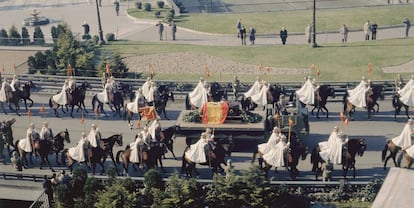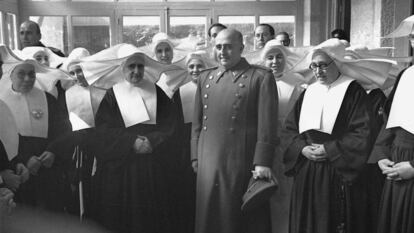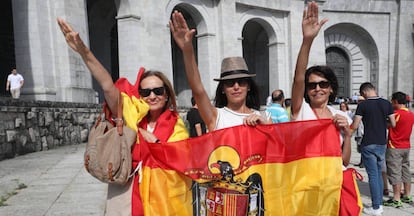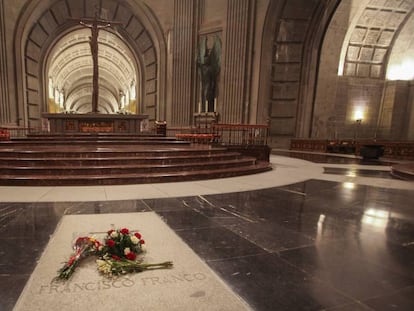Why it’s taken four decades to raise Franco’s tombstone
Removing the former dictator’s remains from the Valley of the Fallen may be technically simple but politically it is wrought with challenges


At 2.15pm on November 23, 1975 – three days after his death – the remains of Spanish dictator Francisco Franco were buried in the Valley of the Fallen monument, north of Madrid. The coffin was placed inside the basilica that the dictator had designed 35 years earlier to immortalize his victory in the Spanish Civil War. It was buried 1.26 meters underground and lined with an alloy of lead and zinc. In a matter of minutes, nine people had maneuvered the 1,500-kilogram tombstone on top of the grave. While it will be a technically simple job to remove the remains, politically, the process is wrought with complications.
Franco did not want to be buried at the Valley of the Fallen, given he was a victor not a victim of the Civil War
The plan to exhume Franco’s body, a story broken by EL PAÍS in June, has shattered the consensus that was reached less than a year ago. In May 2017, Congress passed a non-binding motion from the Spanish Socialist Party (PSOE) to remove the remains with 198 votes in favor, 140 abstentions and only one vote against – a vote made mistakenly by a Popular Party (PP) deputy who had intended to abstain, in line with the rest of her colleagues.
The PSOE government of Prime Minister Pedro Sánchez has designed a legislative decree that will add a pair of articles to the Historical Memory Law thus legally safeguarding the exhumation. Now, however, the conservative PP has said it will appeal the decree at the Constitutional Court, while center-right party Ciudadanos, who voted in favor of the move last year, has said it will abstain.
This is not the first time the Spanish government has tried to remove dictator’s body from the controversial Valley of the Fallen monument. At the end of his second term, PSOE Prime Minister José Luis Rodríguez Zapatero tasked a committee of 12 experts to design a plan for an exhumation. For six months, the committee, made up of specialists from a wide range of fields (from philosophy to law and theology), studied the legalities involved with the monument, removing Franco’s remains and transforming the Valley of the Fallen into a museum of historical memory.

The final report, presented to PP Prime Minister Mariano Rajoy, who had won the 2011 elections, argued that Franco’s family would not need to support the exhumation, nor would the Catholic Church, even though Franco’s tomb is located in a basilica, a holy site that is technically protected by an international agreement. Indeed, the three members of the committee who voted against the exhumation also agreed that the family did not have the power to veto the decision.
In 2017, Congress passed a non-binding motion to remove Franco’s remains
In their separate vote, the three argued that “if the government finds it appropriate to transfer the remains with the dignity required of a burial of a head of state, they must take into account the impact the decision could have on public opinion to avoid public radicalization, have the broadest parliamentary consensus possible and bring negotiations with the relevant ecclesiastical authorities to a positive end.”
Miguel Herrero y Rodríguez de Miñón, one of the committee members against the exhumation who is now a Cabinet member, told EL PAÍS that “with dignity” did not mean “with honor.” He explained that the family’s permission was not mentioned because “they have nothing to say.”
Franco himself did not want to be buried at the Valley of the Fallen, given that he was a victor not a victim of the Civil War. The Valley of the Fallen was ostensibly built to commemorate all of the victims on both sides of Spain’s bitter and bloody domestic conflict, and the remains of more than 33,800 victims of the war lie there.
The exhumation of Franco’s body will be a relief to the families of the victims from the Republican side, who have been unable to reclaim the remains of the loved ones because of the poor condition of the site. Water leaks have ruined the crypts containing the remains, meaning the bones of the victims are mixed up.
The Spanish government wants the exhumation process to be discreet and is likely to repeat the strategy used to remove the remains of Franco General José Sanjura y Mola from Navarre or the statue of Franco from the Nuevos Ministerios square in Madrid, which both took place late at night. The government was alarmed by recent protests held by Franco supporters against the exhumation in the Valley of the Fallen and is hoping to avoid further conflict.

Once the dictator’s body is removed, the next step will be to democratize the monument. It’s been suggested that a public consultation be held to decide the future of the site. While there is little margin in the budget for any grand plan, the government has spent millions of euros in the upkeep of the monument. Since 2012, the Valley of the Fallen received more than €12 million, including a €340,000 subsidy to the Benedictine Abbey.
The Spanish government wants to direct this investment into changing the meaning of the monument, making it clear, for instance, that it was built by 20,000 men, many of whom were political prisoners. With this goal in mind, it will study other examples of sites such as Argentina’s Navy Petty-Officers School (ESMA), a torture center under the military dictatorship that is now the Space for Memory and for the Promotion and Defense of Human Rights.
English version by Melissa Kitson.
Tu suscripción se está usando en otro dispositivo
¿Quieres añadir otro usuario a tu suscripción?
Si continúas leyendo en este dispositivo, no se podrá leer en el otro.
FlechaTu suscripción se está usando en otro dispositivo y solo puedes acceder a EL PAÍS desde un dispositivo a la vez.
Si quieres compartir tu cuenta, cambia tu suscripción a la modalidad Premium, así podrás añadir otro usuario. Cada uno accederá con su propia cuenta de email, lo que os permitirá personalizar vuestra experiencia en EL PAÍS.
¿Tienes una suscripción de empresa? Accede aquí para contratar más cuentas.
En el caso de no saber quién está usando tu cuenta, te recomendamos cambiar tu contraseña aquí.
Si decides continuar compartiendo tu cuenta, este mensaje se mostrará en tu dispositivo y en el de la otra persona que está usando tu cuenta de forma indefinida, afectando a tu experiencia de lectura. Puedes consultar aquí los términos y condiciones de la suscripción digital.
More information
Archived In
Últimas noticias
Pinochet’s victims grapple with José Antonio Kast’s rise in Chile
Reinhard Genzel, Nobel laureate in physics: ‘One-minute videos will never give you the truth’
How Japan is trying to avert ‘digital defeat’
The complicated life of Francesca Albanese: A rising figure in Italy but barred from every bank by Trump’s sanctions
Most viewed
- Pablo Escobar’s hippos: A serious environmental problem, 40 years on
- Why we lost the habit of sleeping in two segments and how that changed our sense of time
- Charles Dubouloz, mountaineering star, retires at 36 with a farewell tour inspired by Walter Bonatti
- Trump’s obsession with putting his name on everything is unprecedented in the United States
- The Florida Keys tourist paradise is besieged by immigration agents: ‘We’ve never seen anything like this’










































